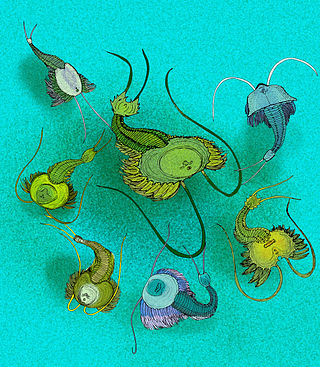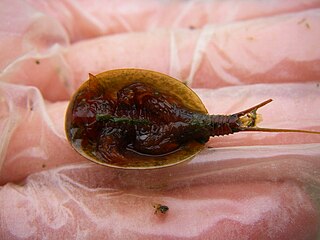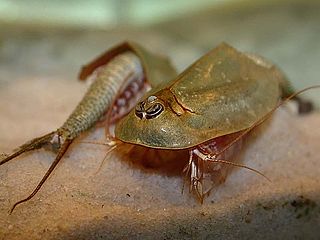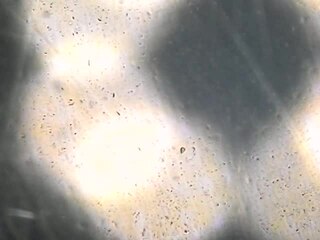
Branchiopoda is a class of crustaceans. It comprises fairy shrimp, clam shrimp, Diplostraca, Notostraca, the Devonian Lepidocaris and possibly the Cambrian Rehbachiella. They are mostly small, freshwater animals that feed on plankton and detritus.

The order Notostraca, containing the single family Triopsidae, is a group of crustaceans known as tadpole shrimp or shield shrimp. The two genera, Triops and Lepidurus, are considered living fossils, with similar forms having existed since the end of the Devonian, around 360 million years ago. They have a broad, flat carapace, which conceals the head and bears a single pair of compound eyes. The abdomen is long, appears to be segmented and bears numerous pairs of flattened legs. The telson is flanked by a pair of long, thin caudal rami. Phenotypic plasticity within taxa makes species-level identification difficult, and is further compounded by variation in the mode of reproduction. Notostracans are omnivores living on the bottom of temporary pools and shallow lakes.

Triops is a genus of small crustaceans in the order Notostraca. The long-lasting resting eggs of several species of Triops are commonly sold in kits as pets. The animals hatch upon contact with fresh water. Most adult-stage Triops have a life expectancy of up to 90 days and can tolerate a pH range of 6 to 10. In nature, they often inhabit temporary pools.

Kazacharthra is an extinct order of branchiopod crustaceans that appear to be closely related to the living order Notostraca. Kazacharthrans lived in marshes and ponds in the Upper Triassic of Western China and Mongolia, and in Lower Jurassic Kazakhstan. It is presumed that the kazacharthrids lived much like their living relatives, in that they were opportunistic omnivores that fed on any available food source, from bacterial biofilms to detritus to smaller animals that could be overpowered.

Triops longicaudatus is a freshwater crustacean of the order Notostraca, resembling a miniature horseshoe crab. It is characterized by an elongated, segmented body, a flattened shield-like brownish carapace covering two thirds of the thorax, and two long filaments on the abdomen. The genus name Triops comes from Greek ὤψ or ṓps, meaning "eye" prefixed with Latin tri-, "three", in reference to its three eyes. Longicaudatus is a Latin neologism combining longus ("long") and caudatus ("tailed"), referring to its long tail structures. Triops longicaudatus is found in fresh water ponds and pools, often in places where few higher forms of life can exist.

Lepidurus packardi, the vernal pool tadpole shrimp, is a small, rare species of tadpole shrimp (Notostraca) found in temporary ponds of the western United States.
Great Valley Grasslands State Park is a state park of California, United States, preserving a parcel of remnant native grassland in the San Joaquin Valley. Such a temperate grasslands, savannas, and shrublands biome was once widespread throughout the whole Central Valley. The 2,826-acre (1,144 ha) park was established in 1982. Largely undeveloped, it was formed by combining two former state park units: San Luis Island and Fremont Ford State Recreation Area. Its chief attractions for visitors are spring wildflowers, fishing, and wildlife watching.

Triops australiensis, sometimes referred to as a shield shrimp, is an Australian species of the tadpole shrimp Triops.

Triops newberryi is a species of Triops found on the western coast of North America, commonly in valleys throughout the states of Washington, Oregon, California, and small areas of Nevada, Utah, New Mexico, and Mexico, with at least one disjunct population in Kansas. They are found in vast numbers though in the Coachella Valley in California. T. newberryi has been reported to have potential as a biocontrol agent for larval mosquitoes breeding in seasonally-flooded habitats. T. newberryi is genetically distinct from T. longicaudatus, the dominant species in the Central United States.

Triops granarius is a species of tadpole shrimp with a broad distribution from Africa and the Middle East to China and Japan, although there are indications that it, as presently defined, is a species complex. They have elongated bodies and large flaps. Triops granarius can be kept as pets in home aquaria. Their life expectancy is up to 90 days, and in that time they can grow more than 6 cm in length.

Triops cancriformis, European tadpole shrimp or tadpole shrimp is a species of tadpole shrimp found in Europe to the Middle East and India.

Arctic tadpole shrimp Lepidurus arcticus is a species of tadpole shrimp which inhabits ephemeral pools, ponds or permanent freshwater lakes of Finland, Norway, Sweden, Svalbard, Greenland, Iceland, Russia and the Kuril Islands.

Chenops is an extinct genus of notostracan which existed in the Yixian Formation, Inner Mongolia, and the Jehol fauna of China during the early Cretaceous period. The genus was erected by Thomas A. Hegna and Ren Dong in 2010 to describe the Yixian species, Chenops yixianensis. A second species, originally described as "Prolepidurus oblongus", from the Jehol fauna, was redescribed as C. oblongus.

Jeholops is an extinct genus of notostracan which existed in the Yixian Formation, inner Mongolia, China during the early Cretaceous period. It was described by Thomas A. Hegna and Ren Dong in 2010, and the only species is Jeholops hongi.

Lepidurus apus, commonly known as a tadpole shrimp, is a notostracan in the family Triopsidae, one of a lineage of shrimp-like crustaceans that have had a similar form since the Triassic period and are considered living fossils. This species is cosmopolitan, inhabiting temporary freshwater ponds over much of the world, and the most widespread of the tadpole shrimps. Like other notostracans, L. apus has a broad carapace, long segmented abdomen, and large numbers of paddle-like legs. It reproduces by a mixture of sexual reproduction and self-fertilisation of females.
Lynceus is a genus of clam shrimp in the family Lynceidae. There are about 13 described species in Lynceus.
Triops mauritanicus is a species of tadpole shrimp, found in Southern Spain and Morocco. This species of Triops can grow to 4 to 6 cm and can be expected to live for 90-120 days on average. This species can be usually found in arid areas and are sometimes sold in kits.
Triop gadensis is a species of arthropod in the genus Triops, that belongs to the family of Triopsidae. Triop gadensis are omnivores and in the wild they mainly eat algae and protozoa; larger triop gadensis that are about 1–2 cm (0.39–0.79 in) in length feed on detritus, plant fibres and tiny crustaceans such as ostracods or copepods. However when food sources are scarce they will cannibalize each other. These crustaceans swim by drag swim power, which is a method of swimming that all triops use.















